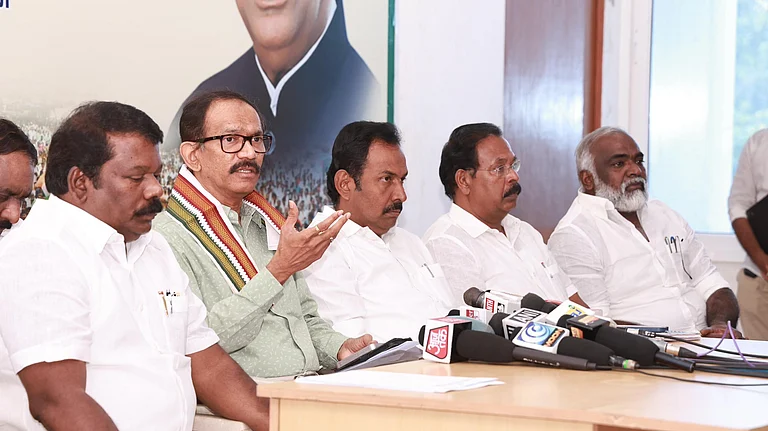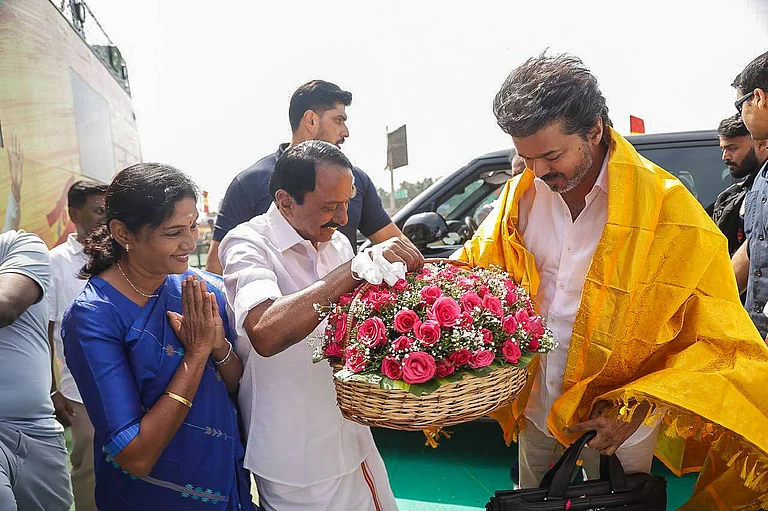Having 39 seats in the Lok Sabha, Tamil Nadu is one of the strategically important states both for the INDIA front as well as the National Democratic Alliance (NDA). With a robust history of anti-Brahmin politics and a strong foundation in Dravidian ideology, Tamil Nadu continues to present a formidable challenge for the Bharatiya Janata Party (BJP), despite successful efforts by the Parivar organisations, including the Rashtriya Swayamsevak Sangh (RSS), to penetrate the state’s cultural fabric.
It is noteworthy that the state has never demonstrated consistency in favouring either the DMK or the AIADMK—the two major political players in the state. In every parliamentary election, the state has been experiencing significant swings towards either of the coalitions, each time operating under different names and led by these two parties. Instead of ideological concerns, charismatic leadership and strategic alliances play a crucial role in determining electoral victories in Tamil Nadu.
In 2004, the DMK-led Democratic Progressive Alliance, comprising the Congress, regional parties like the PMK and the MDMK, and the two communist parties secured all 39 seats, leaving the AIADMK-led NDA at a disadvantage. Interestingly, the AIADMK garnered 30 per cent of the votes, a higher share than the DMK's individual gathering of 25 per cent. The Congress managed to secure 14 per cent of the votes.
In 2009, the DMK managed to win 27 seats, albeit with a notable shift in coalition partners. The DMK-led UPA included the Congress, the VCK, and the IUML in the coalition. The MDMK and the PMK, along with the two communist parties, CPI and CPI (M), which had allied with the DMK in 2004, shifted their allegiance to the AIADMK-led Third Front. However, despite this change, they could only secure 12 seats.
In 2014, the AIADMK marked a thumping victory by sweeping all 39 seats. This time, too, the name of the coalitions and the partners within it changed. Other than the BJP, the AIADMK-led NDA had two regional parties, the DMDK and the PMK, in the coalition. The composition of the DMK lead coalition—this time it was called the Democratic Progressive Alliance (DPA)—also had been drastically changed. The IUML and the VCK were the two coalition partners, apart from a couple of other regional parties.
The Congress and the Left parties contested separately in 2014, which resulted only in splitting votes that effectively went in the favour of the AIADMK and the BJP. The 2014 election embarked the first victory for the BJP into the Parliament—Pon Radhakrishnan of the BJP was elected from Kanyakumari, a constituency lying in Southern Tamil Nadu, neighbouring to Kerala.
In the 2019 election, the first contested after the passing of both Karunanidhi and Jayalalithaa, the stalwarts of the two Dravidian parties, Stalin successfully emerged as the singular and strong leader of the DMK by effectively managing conflicts with his brother Azhagiri.
Conversely, Edappadi Palaniswami of the AIADMK could not ascend to the stature of a charismatic crowd-puller, a crucial aspect in Tamil Nadu politics. Consequently, the DMK, leading the alliance as the SPA (Secular Progressive Alliance), won 38 out of the 39 seats, leaving the AIADMK-led coalition with just one.
In the 2019 Lok Sabha polls, the DMK secured a vote share of 53 per cent while the AIADMK-BJP alliance managed only 30 per cent. There was a significant case of cross-voting by the AIADMK members in favour of the DMK during the 2019 elections, particularly due to the AIADMK’s alliance with the BJP. In the 2021 Assembly polls, the BJP's vote share plummeted to a mere 3 per cent, signifying a noteworthy shift in electoral dynamics.
However, this time, the BJP is targeting three constituencies—Chennai South, Kanyakumari, and Coimbatore. In Chennai South, the BJP managed to gather 25 per cent of the votes in the 2014 Lok Sabha election, which was a significantly high turnout compared to the party’s overall performance in the state. With a considerable population of upper-caste communities, particularly Brahmins, the BJP hopes to polarise these votes in its favour. However, in 2019, the DMK won this constituency with a significant margin of 22 per cent votes, securing 50 per cent of the total votes polled.
Kanyakumari is the only constituency from which the BJP could send its lone member—Pon Radhakrishnan—to the Lok Sabha, gathering 38 per cent of the votes, while the Congress, which pushed to the second place, won 24 per cent of the votes. However, this is not expected to repeat because all major parties—the DMK, the AIADMK, and the Congress—contested separately, resulting in the splitting up of votes. In 2019, the Congress, an alliance partner of the DMK, won this seat with 60 per cent of the votes, while the BJP’s Pon Radhakrishnan, who contested in the AIADMK coalition, was pushed to second place with 35 per cent of the votes.
A by-election was held in Kanyakumari in 2021 following the demise of H Vasanthakumar of the INC, in which the Congress retained the seat with 53 per cent of the votes. The BJP’s Pon Radhakrishnan, who improved his vote share to 39 per cent, is being fielded this time, too, with an expectation to win. However, as a constituency with a substantial vote share of the Christian community, it is not going to be easy for the BJP, though the party could mobilise the Hindu Nadar community to a large extent.
Coimbatore, where the BJP state chief Annamalai is contesting, is another constituency where the BJP has been putting up a fight to win. The BJP has come in second place since the last two elections in this constituency, garnering no less than 34 per cent of the votes—in 2019, this figure came down to 31 per cent. The seat was allotted to the CPI (M), the alliance partner of the DMK in 2019, but has been taken by the DMK this time, probably considering Annamalai, who is the face of the BJP in Tamil Nadu, as a strong opponent.
Annamalai’s aggressive style and unapologetic anti-Dravidian stance brought him immense popularity among the party workers in the state. However, as far as the Dravidian parties are concerned, people would reject him for the same reasons. Annamalai has often been embroiled in controversies due to his fierce responses.
Last year in November, he created uproar in the state by stating that all the statues of Periyar should be removed, as he was a man who promoted atheism. He stated that those statues would be removed as soon as the BJP came to power. He hit the headlines with another statement against Dravidian stalwart and former Chief Minister C N Annadurai, stating that he mocked Hinduism during an event in Madurai in 1956. Annamalai’s vociferous stands contributed to the breakdown of the relationship between the AIADMK and the BJP. In January 2024, he was booked under Section 153A of the IPC for promoting religious enmity between two groups, for allegedly trying to enter a church. A group of Catholic youth objected to his entry into the St Lourde Church in Bommidi in Dharmapuri district, and an altercation allegedly occurred between him and the group of youngsters. Coimbatore, in other words, would be the ‘laboratory’ testing whether aggressive Hindutva would translate into votes or not.
The AIADMK, which broke ties with the BJP, is hoping to make a comeback by mobilising anti-incumbency factors against the Stalin government. The party has suffered erosion in its mass base after the death of Jayalalithaa. In 2014, the AIADMK, which won 37 seats, was the third-largest party in the House. It fell steeply to one seat in 2019 and is thus struggling to strengthen its base in the state. Parting ways with the BJP is one of the remedial actions the party is considering, given the resentment among the cadres against the assertion of aggressive Hindutva against Dravidian identity. Besides, the party is hoping to mobilise the anti-incumbency factor to turn into votes in its favour.
On the other hand, M K Stalin and his son and cabinet minister, actor, and filmmaker Udayanidhi Stalin have launched severe attacks on the BJP and the Union Government on issues of federalism and communal polarisation. The manifesto released by the DMK makes it clear that the party has taken up this election as an ideological war against the government, which denies the legitimate revenue share of the state. The AIADMK and DMK, known as arch-rivals, engage in a war of words against each other and have set the ground for a two-party fight except in a few constituencies that go for a three-cornered fight.


























